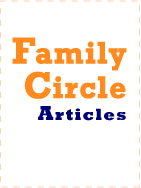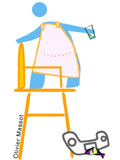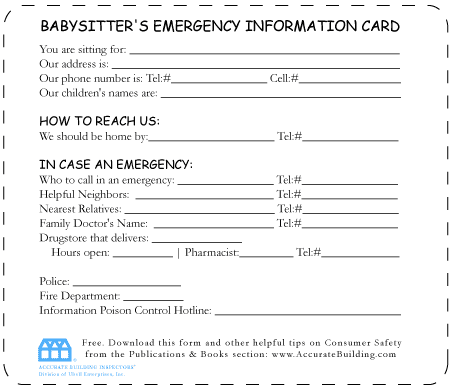- Publications:
- Newsletter:
- How-To Tutorials:
- Consumer Guides:
- Related:

A Safe Place for Kids
[Family Circle Archive]

Make Your Home a Safe
Place for Kids: Household Safety Guide
By Al Ubell and Label Shulman
Published August 2, 1983
Family Circle Magazine

In 1981, 10,500 children were injured in highchairs and 385,500 kids were hurt on bicycles. Whats a parent to do? Follow our safety pointers.
Seemingly innocent household objects like doors, faucets, toys and furniture can be dangerous to unsuspecting kids. Over nine million children were hurt in accidents around the home in 1981 - 3,000 of these injuries were fatal. As a parent, you can help minimize the mishaps in your children's lives. With the expert advice of the U.S. Consumer Product Safety Commission and the National Safety Council, Family Circle has developed the following test. Take it to see if your home is a safe place for kids.
Test Your Child Safety Awareness
The following quiz consists of 60 statements covering safety issues that affect all children (with a special section for kids less than 18 months old). Read each statement carefully, then answer YES or NO, depending upon whether it is mostly true or mostly untrue. Each YES is worth 10 points; a NO gets zero. (Give yourself a YES credit 10 points - for any situation that does not apply to your home.) Add up your YES answers and check your “Safety Score Rating”.
For Children of All Ages:
- You never allow children to play with electrical appliances.
- You never place small appliances near the edge of a cabinet, table or dresser. (They might be pulled down accidentally by small children.)
- You always unplug the iron and put it out of a child's reach, even if you stop ironing for just a few minutes.
- You make sure that the electrical cords to lamps, appliances and televisions are kept out of areas where children walk, crawl or play.
- When throwing out or storing refrigerators, freezers, washers and dryers, you remove the doors first.
- Your electric garage-door opener is equipped with a safety stop to prevent accidental crushing of children.
- You read all the instructions accompanying electrically-operated toys and supervise your children when they're playing with them.
- You always choose toys that are recommended for your child's age group (look for the recommended ages on the packaging) and check for sharp edge or broken pieces before you buy them.
- You have removed the free-falling lid on the toy chest or have installed a lid support device. (Serious injuries have been reported to kids' heads and necks, and some have even been killed when the lid dropped and trapped the head.)
Child Safety Gadgets You Should Know About
Cabinet Safety Latches: These plastic devices are easy to install on the inside face of cabinet doors. They require a bit of dexterity to unlatch.
Safety Dots: Decorative decals for large glass panels. These are applied to glass surfaces (such as patio doors) to make them visually apparent to fast-moving children.
Anti-Mouth-Burn extension cords: These cords feature special plugs that prevent contact with the metal “male” prong that conducts electrical current and is exposed in conventional extension cords. They are available at hardware stores.
Special Safety Aids
“Mr. Yuk” poison Warning Safety Caps: Designed to be affixed to dangerous and poisonous products in the home, “Mr. Yuk” stickers proved effective in tests with preschool kids, who learned to avoid bottles marked with the scowling green face. This easily recognized symbol now adorns a set of three graduated size, child-resistant aluminum bottle caps. They'll help keep the harmful contents of most any-size bottle from prying fingers. For a free sheet of Mr. Yuk stickers, send a self-addressed, stamped business-size (#10) envelope to:
Free Mr. Yuk Stickers
Pittsburgh Poison Center
3705 Fifth Ave.
Pittsburgh, PA 15213
Free babysitting booklet
“Every job has certain guidelines. Babysitting is no exception,” notes the U.S. Consumer Product Safety Commission in the booklet, “The Super Sitter” (or visit the CPSC website: www.cpsc.gov/cpscpub/pubs/243.html . It offers valuable advice on the do's and don'ts of keeping a careful eye on children, as well as play-time ideas, outdoor safety tips and what to do in an emergency. To obtain a single copy of “The Super Sitter,” call the U.S. Consumer Product Safety Commission's toll-free hotline: 1-800-638-CPSC.
Parents' & Babysitter's Checklist
Use this handy checklist to remind you of important information to tell the sitter.
Children's Care Tips:
- What to feed the children?
- Explain special habits or nighttime routines, including bedtime.
- What television-viewing guidelines do you have for the kids?
- What games or books do the children like?
- Explain where pajamas, diapers, etc., are located.
- Advise sitter of any medication your children take.
- Specify what snacks sitter and children can eat; what's off-limits.
House Facts:
- Give a quick tour of the house.
- Point out the emergency phone numbers on this card and post it by the phone.
- Explain how any special lights or equipment work.
- Show sitter how to operate stove, TV, stereo, etc.
- Have a note pad handy for sitter to record any phone messages.
Safety Pointers:
- Explain how door locks work and where spare keys are kept, just in case someone gets locked out of the house.
- Point out medicine cabinet and first-aid supplies.
- Explain smoke or burglar alarms and procedures.
- Leave a flashlight in an easy-to-reach place.
Special Rules for Sitter:
- No smoking or drinking alcoholic beverages.
- Don't talk on the phone all night, tying up the lines. No friends visiting, unless approved.
Free Babysitter's Emergency Information Card
PDF Download: ![]() Babysitter Card (59KB)
Babysitter Card (59KB)


Copyright © Alvin Ubell, Label Shulman & Family Circle Magazine - 1983




